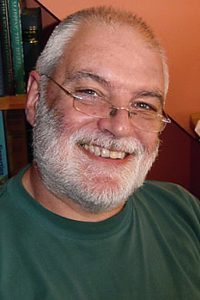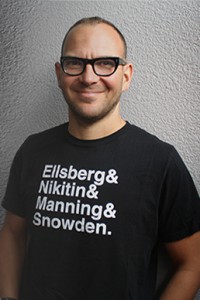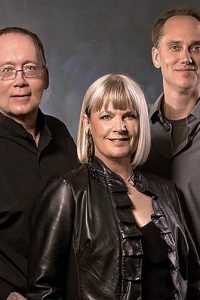John Crowley: As the Crow Flies

John Michael Crowley was born December 1, 1942 in Presque Isle ME, where his father, a doctor and captain in the Army Air Corps, was stationed. The family moved several times, settling in Indiana in 1953 when his father took a position as a doctor at Notre Dame. Crowley attended Indiana University, earning a degree in English in 1964. He moved to New York and worked as a photographer’s assistant, and later as a freelance photographer and documentary film writer. He became a freelance writer in 1966 and began teaching fiction at Yale University in 1993.
Crowley writes SF, fantasy, and mainstream literary work, often blurring genre distinctions. His first three novels were (mostly) SF: The Deep (1975), Beasts (1976), and Engine Summer (1979); they were collected in omnibus Otherwise: Three Novels (1994). He turned to literary fantasy with Little, Big (1981), winner of a World Fantasy Award and perhaps his best-known work, called “a neglected masterpiece” by critic Harold Bloom.
He embarked on his hugely ambitious Ægypt series with Ægypt (1987), followed by Love & Sleep (1994), Dæmonomania (2000), and Endless Things (2007).
Other novels include not-quite mainstream novel The Translator (2002) and an ambitious historical, Lord Byron’s Novel: The Evening Land (2005), which includes a fictional novel by the poet. Four Freedoms (2008) is also historical, set in an American aircraft factory during WWII. His newest novel is a return to fantasy: Ka: Dar Oakley in the Ruin of Ymr (2017).
Crowley’s short fiction is also celebrated, with “Novelty” (1983) a British Science Fiction Association Award finalist; “Snow” (1985), a Hugo and Nebula Award finalist; “Great Work of Time” (1989), a World Fantasy Award winner and Nebula Award finalist; and “Gone” (1996), a Hugo and Sturgeon Memorial Award finalist and winner of a Locus Award. His short work has been collected in the World Fantasy Award-winner Novelty (1989), Antiquities (1993), Novelties & Souvenirs (2004), and Totalitopia (2017). Some of his non-fiction was gathered as In Other Words (2007). His work was the subject of critical study Snake’s-Hands: The Fiction of John Crowley, edited by Alice K. Turner & Michael Andre-Driussi (2003).
His scripts for educational films and documentaries include The World of Tomorrow, on the 1939 World’s Fair, and No Place to Hide, on the 1950s bomb shelter craze. He has worked with his wife Laurie Block on documentaries produced by her media company Straight Ahead Pictures. He updated the language of 17th-century alchemical novel The Chemical Wedding by Johann Valentin Andreae for modern readers for a new edition from Small Beer Press (2017).
Crowley’s numerous awards include an American Academy and Institute of Arts and Letters Award in Literature (1992) and a World Fantasy Life Achievement Award (2006).
He married Laurie Block in 1984, and their twin daughters were born in 1987. They live in Massachusetts.
Excerpts from the interview:
“Here’s the thing about Ka. The other novels I’d written recently weren’t fantastic. Four Freedoms, and before that Lord Byron’s Novel, and The Translator – that last one is secretly fantastic, but it can be read without much attention to that. They didn’t do very well, frankly. Some of them got good reviews. Some of them were ignored. None of them were a huge success with readers, and I think it’s partly because the people who like my fantasy and science fiction didn’t want to pick that other stuff up. There is a class of science fiction fantasy readers who will read whatever they think is good, but, I’m sorry to say, it’s a small number. So I said, okay, if I’m going to write – and I’m coming to understand I don’t have a lot more novels to write – if I’m going to write one more, I ought to try to recapture that readership. I set out quite consciously to recapture the fantasy readers. Not only with talking animals, which is one form of fantasy, but by having that talking animal visit underworlds and overworlds, places human beings have been caught in for millennia.
“Ka: Dar Oakley in the Ruin of Ymr is a deliberately puzzling title. It’s about a crow who gets the name Dar Oakley through a series of adventures. He’s the first crow to ever have a name, and he claims to have invented names for crows. He’s born sometime in an apparently Celtic world – I never made this specific even to myself – about 2,000 years ago, sometime before the British invasion of Gaul. He was born into a realm where there were no people, because humans had not yet reached there. Very soon in his young years, when human populations start to come into the area, he is fascinated by them and by the kind of things they do – building fires, building houses, running around on two legs, and above all having battles with one another. Killing, but not eating, other humans. The crows cannot figure that part out, but they also realize they’ve discovered a treasure they couldn’t have conceived of. There is wealth beyond the dreams of gluttony laid out before them after these battles, and the humans are glad to have them eating the bodies, as long as it’s the enemy dead. He, Dar Oakley, feels he caused this bounty.
“Dar Oakley now has a big connection with humans, and because of his curious nature, he makes friends with a young human girl. Through a procedure that I think was the only reasonable possible one, they become able to communicate. She speaks in the language she knows, and he has come to understand it. He speaks in the language he knows, because he can’t speak in any human language. She can’t speak in crow, but she comes to understand him speaking in the language of crows, which we mostly can’t hear – we hear ‘Caw, caw, caw,’ but we don’t hear them talk to each other, because we’re rarely close enough, or they don’t talk when we’re around. The two become great friends, and through him she changes and understands things, and through her he comes to understand that death is not what he thinks it is. Crows don’t have the concept of an afterlife – they just die and that’s that. They miss their loved ones who are dead, but they don’t brood on their future. She knows that’s not so. She is, like all human beings, completely wrapped up in wondering what happens to the dead, thinking about what we do with the dead – where are they now, are they going to be there forever, are they going to come back, can we go there? With her, Dar Oakley goes down into a Celtic underworld, sort of like in Irish legend where you can go in and meet heroes and deathless people who are repeating the old feasts and battles still – but she goes down there for a specific purpose.
“She knows that down under the earth somewhere in this other world, there is something you could get and bring back to human beings to keep them from ever dying. She calls it ‘the most precious thing.’ She has to go down there and get that most precious thing. Dar Oakley says, ‘Okay, I’ll go with you.’ He goes down with her into this underworld and together they find the thing she sought. He doesn’t want it – he knows it’s not for him. It’s for people. But through a series of accidents, he ends up having it, instead of her. He almost immediately loses it, because that’s what happens. You don’t get to keep such things. We know that from a thousand stories. He loses it in a very common folktale way, and she of course is heartbroken, and he is deeply sad about it, but life goes on. Various things happen, and he mates with another crow, they have kids, and so on. Eventually, even though his mate and other crows that he knows die, and his human friend grows old and becomes a priestess within the community, then dies – he doesn’t die. He doesn’t exactly understand why, although he thinks it has something to do with that event under the earth. But then, finally, near the end of part one, which is like a third of the book, he’s hanging out with his crow friends and these people show up. His friend the priestess had predicted them: ‘Someday there’s going to be an enemy that nothing can stop. They’ll kill us all, they’ll walk all over us, they’ll kill our children, and there’s nothing we can do about it.’ The crow sees the enemy on their way with their armor jingling, and a guy with a big tall hat, and these banners that have a bird at the top, but they’re not crows, they’re eagles. A guy in a red cloak leads them. Dar Oakley flies over their heads and one of the archers accompanying this group shoots him and he dies.”








